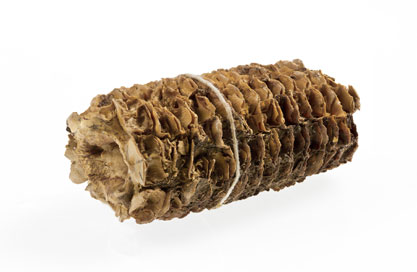Corn Cob
Zea mays
Circa Pueblo II Period AD 900-1150
L 6.5cm, D 2cm
Lake Mead National Recreation Area, LAKE 3315
See more
Hide this content
The Ancestral Pueblo people practiced agriculture growing corn, beans and squash along the Virgin and Muddy rivers. Known as the “three sisters”, the combination of these three foods provided much of their nutritional needs. The Ancestral Pueblo people practiced their agriculture on mesa tops, where the crops could catch the sun's rays and also along river banks that would seasonally flood and water the crops. They developed a number of techniques to conserve water in order to grow plants in the desert. For instance, they used pumice, a light, frothy rock that is full of gas that acts as a sponge, absorbing water and releasing it slowly over time. They also practiced terracing, built check dams to slow the flow of water across slopes and built waffle or grid gardens forming small depressions with a low earthen wall. In addition, corn is sun-tolerant and grows tall, providing shelter for the shorter beans and squash plants that are less tolerant of the sun.
References:
Lake Mead National Park Service
http://www.nps.gov/band/historyculture/ancestral-pueblo-farming.htm



Corn Cob
Food
Circa Pueblo II Period AD 900-1150
L 6.5cm, D 2cm
Lake Mead National Recreation Area, LAKE 3315
See more
Hide this content
The Ancestral Pueblo people practiced agriculture growing corn, beans and squash along the Virgin and Muddy rivers. Known as the “three sisters”, the combination of these three foods provided much of their nutritional needs. The Ancestral Pueblo people practiced their agriculture on mesa tops, where the crops could catch the sun's rays and also along river banks that would seasonally flood and water the crops. They developed a number of techniques to conserve water in order to grow plants in the desert. For instance, they used pumice, a light, frothy rock that is full of gas that acts as a sponge, absorbing water and releasing it slowly over time. They also practiced terracing, built check dams to slow the flow of water across slopes and built waffle or grid gardens forming small depressions with a low earthen wall. In addition, corn is sun-tolerant and grows tall, providing shelter for the shorter beans and squash plants that are less tolerant of the sun.
References:
Lake Mead National Park Service
http://www.nps.gov/band/historyculture/ancestral-pueblo-farming.htm







